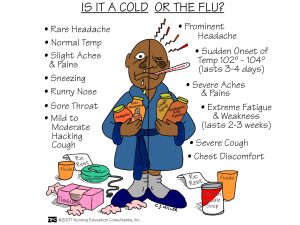
Nikki Defruscio, Contributing Writer |
On Thursday, September 14, the Health Center issued an email to all students informing them of “a longer than expected wait time for appointments.”
When interviewing Margaret Benjamin, a nurse at the Health Center, she said that this setback was not due to an increase in sickness at the beginning of the semester, despite popular belief.
She explained, “There is not a spike of illnesses at the beginning of the school year, nor is there a difference from the start to the finish of the school year.”
However, the Center for Disease Control and Prevention says otherwise: “While seasonal influenza (flu) viruses can be detected year-round in the United States, flu viruses are most common during the fall and winter. The exact timing and duration of flu seasons can vary, but influenza activity often begins to increase in October. Most of the time, flu activity peaks between December and February, although activity can last as late as May.”
Many aspects could be at play here, contributing to the revolving door of students at the Health Center. Greek life’s Rush Week, full of jam-packed parties, could be a possible factor.
The Center for Disease Control’s website states, “People with the flu can spread it to others up to about 6 feet away.”
Most experts think that flu viruses are spread mainly by the droplets expelled when people with the flu cough, sneeze, or talk. These droplets can land in the mouths or noses of people who are nearby to possibly be inhaled into the lungs.
Less often, a person might get the flu by touching a surface that has the flu virus on it and then touching their own mouth or nose.
The close spaces and shared drinks at parties and in dorm halls can definitely facilitate the spread of germs.
Benjamin shared yet another possible reason for these constant visits: “We do see a lot of students for cold symptoms that don’t necessarily need to be seen. They don’t seem to realize they just have a cold, that symptoms can be treated with over the counter medications, and do not require antibiotics.”
In order to avoid confusion, the Health Center provides many tips online to determine when a visit is necessary, and they even includes helpful pointers on how to stay healthy. The site covers everything from how important sleep is for the body to nutritional facts and effects of various alcoholic drinks.
Benjamin also attested that, “This year we are seeing a giant spike in freshmen visits.”
This could be due to the fact that this year’s freshmen class has seen an increase in population, which could have to do with the recent development of the degree program, The Excelsior Scholarship. This scholarship promises free tuition to those eligible and willing to live in New York for a few years after receiving their degree. This scholarship only applies to SUNY and CUNY schools, explaining the rise in the freshmen class.
Unaware of the resources available to them, freshmen could be victim to misconceptions on when a Health Center visit is essential, especially if they’re not used to treating these common colds themselves.
With our immune systems weak from the less exposed surfaces of our houses back home, we all become more prone to illness. In order to prevent superfluous visits to the Health Center and contraction of the common cold, visit the Health Center’s website to educate yourself.

Leave a Reply